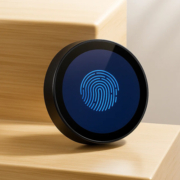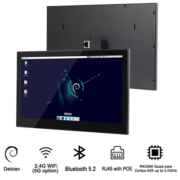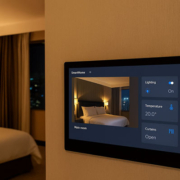How Do Smart Home Control Systems Work?
A smart home automation system is a network of interconnected devices and technologies that enable homeowners to control, monitor, and automate household functions through a central interface or mobile app. These systems aim to make homes more convenient, secure, energy-efficient, and intelligent by automating everyday tasks and allowing remote control from anywhere in the world.
Key Components of a Smart Home Automation System
1. Smart Devices and Sensors
These include devices like smart lights, thermostats, door locks, security cameras, motion sensors, curtain motors, appliances, and audio systems. They are equipped with connectivity features such as Wi-Fi, Zigbee, Z-Wave, Bluetooth, or RS485 to communicate with each other and the control system.
2. Central Control Hub or Panel
At the heart of a smart home is a control panel or hub — a physical touchscreen interface (like those provided by Portworld) or a software-based control app. This is where all devices are monitored and managed, scenes are created, and automation rules are defined.
3. Mobile App or Cloud Control
Modern smart home systems offer remote access via smartphone apps, allowing users to control lighting, temperature, security systems, or home appliances while away from home. These apps are often cloud-connected for seamless operation.
4. Voice Assistant Integration
Smart homes commonly support Amazon Alexa, Google Assistant, or Apple Siri, allowing users to control devices through simple voice commands — such as “Turn off the lights” or “Set the thermostat to 72°F.”
5. Automation Rules and Scheduling
Automation is the core of a smart home system. You can set rules like:
- Turn on the lights when motion is detected.
- Close the curtains and turn off lights at bedtime.
- Start the coffee machine at 7:00 a.m. daily.
- Trigger an alarm and notify your phone when a door is opened while you’re away.
Benefits of a Smart Home Automation System
- Convenience: Automate routine tasks and manage your entire home with a few taps or voice commands.
- Energy Efficiency: Automatically adjust lights, HVAC, and appliances to save power and reduce bills.
- Enhanced Security: Monitor your home in real-time, receive alerts, and control access remotely.
- Customization: Create personalized scenes like “Movie Night” or “Work Mode” that adjust multiple settings at once.
- Remote Access: Stay in control of your home from anywhere using mobile or web apps.
Use Cases
- Smart Living: Control lights, curtains, and music with a single wall-mounted touch panel.
- Home Security: Automate door locks, monitor surveillance cameras, and receive motion alerts.
- Elderly Care: Set up reminders and environmental controls to assist aging family members.
- Energy Saving: Use smart thermostats, plugs, and occupancy sensors to reduce energy usage.
Example: Portworld Smart Home Control Panels
Portworld offers Android-based smart touch panels in various sizes (5.5″, 8″, 10″) that serve as the central interface for home automation systems. With support for PoE, RS485, Wi-Fi, Bluetooth, and multi-protocol compatibility (Zigbee, KNX, Modbus), these panels are ideal for managing lighting, HVAC, curtain motors, intercoms, and more. OEM/ODM customization is also available, making them suitable for both residential and commercial projects.
A smart home automation system is more than a trend — it’s the future of modern living. By integrating smart devices, intuitive controls, and intelligent automation, homeowners can enjoy greater comfort, efficiency, and security in their everyday lives.
Whether you’re a tech enthusiast or just looking for a more convenient lifestyle, investing in a smart home system is a step toward smarter, safer, and more sustainable living.










